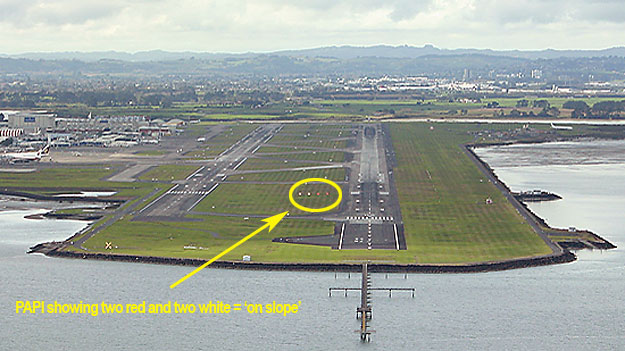
The same problems
with the old red-white VASIS which led to the development of T-VASIS
in Australia also led to the development of the Precision Approach Path
Indicator (PAPI) system. PAPI was developed by the Royal Aircraft Establishment
in the UK in the late 1970s. Subsequently the ICAO
Aerodromes, Air Routes and Ground Aids (AGA) Divisional Meeting held on
April 22-May 15, 1981 recommended that PAPI be adopted in Annex 14 to
the Chicago Convention as a standard visual approach aid (alongside T-VASIS).
The PAPI system uses a set of four two-colour, high intensity light projectors arrayed alongside the runway (above & below at Avalon in March 2005). The beam from each projector consists of a white upper half and red lower half. The transition from one colour to the other occurs over a very vertical small angle and this sharp transition is an essential feature of the PAPI system. The projectors are mounted on adjustable, frangible legs.

The PAPI system
is installed on one or both sides of the runway at the touchdown aiming
point, as the photo below of Runway 05R at Auckland, New Zealand, shows.
The lights are arranged to show two red and two white lights when on the
correct approach slope (usually 3 degrees). When high on approach first
three, then four, white lights are displayed. Similarly when low on approach
first three, then four, red lights are displayed.
PAPI was approved for use in Australia in the early 1990s and is gradually replacing the more expensive T-VASIS. Click here for another view of PAPI from the pilot's point of view.

The photo below illustrates the location of the PAPI array at the touchdown
aiming point. This installation is on Avalon's Runway 18 as seen in March
2005. The aircraft is Jetstar Airways' Boeing 717-231 VH-VQI (cn 55095).
This aircraft was originally delivered to TWA as N428TW on 7 November 2001 but transferred to American Airlines a month later. On 30 April 2002 it was obtained by and operated in Qantas colours by Qantaslink - a brand name used by newly-acquired Qantas subsidiary Impulse Airlines. This operation metamorphosised into Jetstar Airways, and VH-VQI was re-registered to Jetstar on 8 May 2004. Jetstar subsequently transitioned to an all-Airbus fleet and VH-VQI was put in storage at Tamworth between May and December 2006. On 15 January 2006 it was re-registered VH-YQI to free up VH-VQI for a new A320. The aircraft was then sold to National Jet Systems on 16 October 2007 to operate, once again, in Qantas/Qantaslink colours as VH-NXN on their Western Australian services.

(Photos:
Phil Vabre)
Back to the main Communications & Navigation index
Click here to return to the main Airports & Aerodromes index
If this page appears without a menu bar at top and left, click here